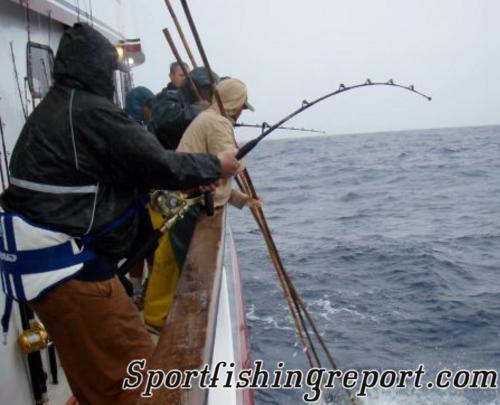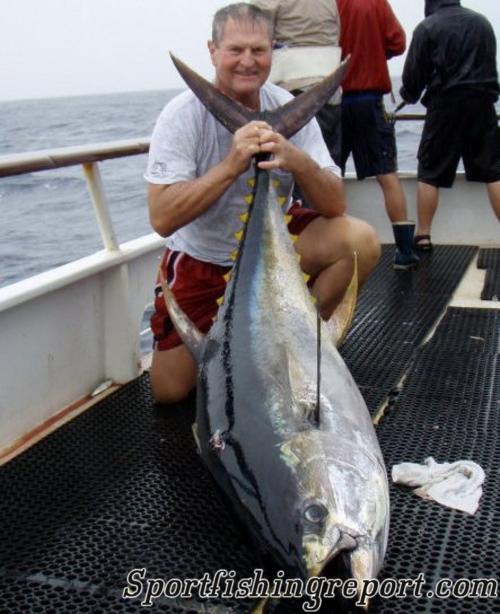Utah Fish Report
Fish Report for 1-18-2009
Fish Report for 1-18-2009
Shogun Last Day Report
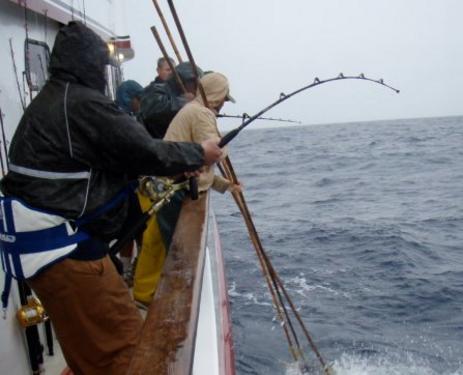
by Bill Roecker
1-18-2009
(619) 226-8030
Website
"Rain and with it brought biting fish for us here," wrote Shogun skipper Bruce Smith, "on our last day at the Hurricane bank. Most of the yellowfin today were smaller, in the 70 to 110-pound class, but a smattering of fish in the 165 to 185 were also brought on board. The wahoo were jumping around us and there were quite a few bite-offs, but with the pressure they have received lately its tough to get them to bite and your best chance is with short light wire leader, small hook and thirty pound or a surface iron without wire. It was a great day in the warm rain, a nice way to end the trip."
Good Advice For Big Tuna: Bruce Smith's Remarks January 18, 2009
"?ĶWe are traveling and we are done scrubbing the boat. This is not pointed at any one person, but these are things or circumstances that I see and hopefully can help you on future trips to land a fish of a lifetime. A passenger had hooked a nice fish, a big one, maybe over 200 pounds. He fought the fish admirably, but after a time his line broke and the fish swam free. After a few minutes of recollection, he came to me showed me the end of his line and asked what happened, what did he do wrong. Well, I could have just told him his knot broke and have been done with it, but that's not it. That is not the whole story. The reason he lost that fish was because he didn't pull hard enough early enough in the fight while his terminal tackle (knots, crimps or whatever) still had the strength to be pulled on.
"Actually what happened was that he had crimp his mono and the crimp slipped which caused the line to break at the hook. He could have done a better job of crimping, but really this is beside the point. If he had put the coals to that fish in the first half hour that sleeve would have held fine. Now, you don't want to try and stop a big fish if he is going away from you. You won't, something will break, give him his head, let the fish go under a relatively tight drag, but not stupid tight. When that fish stops is when you start gaining line. Line should be going off your reel or coming back onto your reel. I would say that there are maybe 5% of the anglers that come out here that understand just how hard you can pull on 100-pound line, much less 130.
"You will say "I don't want to pull the hook", well you really don't have much choice in pulled hooks. It's a sad case, but sometimes luck isn't in your favor and the hook pulls, really it doesn't have to do with how hard you are pulling on the fish. This is more with the size of hook you are fishing, bigger the hook the less often they pull. A good comparison is that when you hook that big yellowfin a timer has started. When that timer goes off is when your line breaks, because its going to break eventually and the longer you are on that fish the bigger the chance you are going to break something.
"Then I had another instance. The fish is just outside of deep color, doing circles for fifteen minutes. I suggested that we should push the drag up. I got this answer, ???It's already at 33 pounds.'"
"I don't care if that drag is at 133 pounds; if you aren't moving that fish and you're standing there watching him wear a hole in it mouth, it's time to increase the drag! That poundage number is overrated and should only be used as a mark, nothing more. 33 or 23 pounds means nothing if you can't gain line when you need to. It's great to use a scale to set your drag, but don't let that stop you from increasing the amount throughout the fight.
"Towards the end, as that fish gets close you will almost always be bumping your drag up in small increments, to keep gaining line. There are very few times that you can't move that fish or it hangs at deep color doing circles. Each circle is one more closer to your line coming apart. Be smart with the amount of pressure you are applying, have respect for the fish, use the proper tackle for the size of fish you are angling for, and most of all have a good time. Sometimes it takes a few trips to land that goal-reaching fish. Many very good anglers have made trips year after year before they got their first 200-pounders. They deserve our respect."
Shogun is scheduled to arrive at Fisherman's Landing January 21.
Good Advice For Big Tuna: Bruce Smith's Remarks January 18, 2009
"?ĶWe are traveling and we are done scrubbing the boat. This is not pointed at any one person, but these are things or circumstances that I see and hopefully can help you on future trips to land a fish of a lifetime. A passenger had hooked a nice fish, a big one, maybe over 200 pounds. He fought the fish admirably, but after a time his line broke and the fish swam free. After a few minutes of recollection, he came to me showed me the end of his line and asked what happened, what did he do wrong. Well, I could have just told him his knot broke and have been done with it, but that's not it. That is not the whole story. The reason he lost that fish was because he didn't pull hard enough early enough in the fight while his terminal tackle (knots, crimps or whatever) still had the strength to be pulled on.
"Actually what happened was that he had crimp his mono and the crimp slipped which caused the line to break at the hook. He could have done a better job of crimping, but really this is beside the point. If he had put the coals to that fish in the first half hour that sleeve would have held fine. Now, you don't want to try and stop a big fish if he is going away from you. You won't, something will break, give him his head, let the fish go under a relatively tight drag, but not stupid tight. When that fish stops is when you start gaining line. Line should be going off your reel or coming back onto your reel. I would say that there are maybe 5% of the anglers that come out here that understand just how hard you can pull on 100-pound line, much less 130.
"You will say "I don't want to pull the hook", well you really don't have much choice in pulled hooks. It's a sad case, but sometimes luck isn't in your favor and the hook pulls, really it doesn't have to do with how hard you are pulling on the fish. This is more with the size of hook you are fishing, bigger the hook the less often they pull. A good comparison is that when you hook that big yellowfin a timer has started. When that timer goes off is when your line breaks, because its going to break eventually and the longer you are on that fish the bigger the chance you are going to break something.
"Then I had another instance. The fish is just outside of deep color, doing circles for fifteen minutes. I suggested that we should push the drag up. I got this answer, ???It's already at 33 pounds.'"
"I don't care if that drag is at 133 pounds; if you aren't moving that fish and you're standing there watching him wear a hole in it mouth, it's time to increase the drag! That poundage number is overrated and should only be used as a mark, nothing more. 33 or 23 pounds means nothing if you can't gain line when you need to. It's great to use a scale to set your drag, but don't let that stop you from increasing the amount throughout the fight.
"Towards the end, as that fish gets close you will almost always be bumping your drag up in small increments, to keep gaining line. There are very few times that you can't move that fish or it hangs at deep color doing circles. Each circle is one more closer to your line coming apart. Be smart with the amount of pressure you are applying, have respect for the fish, use the proper tackle for the size of fish you are angling for, and most of all have a good time. Sometimes it takes a few trips to land that goal-reaching fish. Many very good anglers have made trips year after year before they got their first 200-pounders. They deserve our respect."
Shogun is scheduled to arrive at Fisherman's Landing January 21.
Photos
More Reports
Taka Tanaka Takes Top Tuna
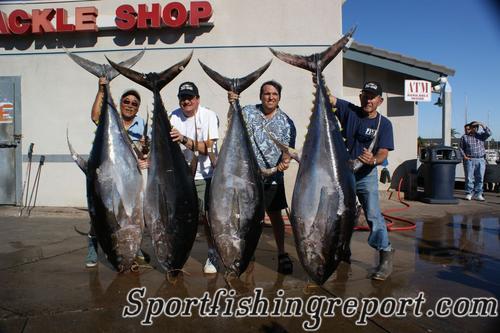
1-17-2009
Roy Rose docked Royal Polaris January 17, after a 17 ?? day trip sponsored by Taka Tanaka, whose tackle shop...... Read More
Lots of Cows Jumping
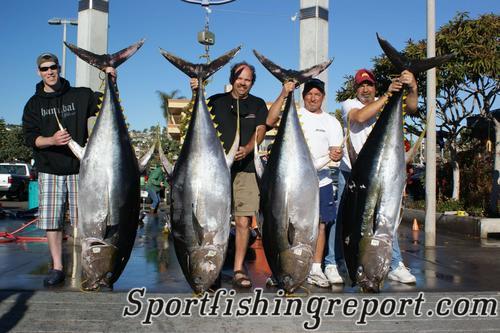
1-16-2009
A ten-day Accurate trip to the southern banks arrived January 16 when skipper Brian Kiyohara docked American Angler at Pt....... Read More

www.UtahFishReports.com © 2025. All Rights Reserved.
Website Hosting and Design provided by TECK.net
Website Hosting and Design provided by TECK.net
